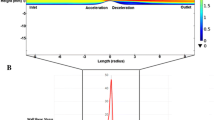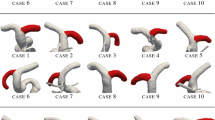Abstract
Cerebral aneurysms develop near bifurcation apices, where complex hemodynamics occur: Flow impinges on the apex, accelerates into branches, then slows again distally, creating high wall shear stress (WSS) and positive and negative spatial gradients in WSS (WSSG). Endothelial responses to these kinds of high WSS hemodynamic environments are not well characterized. We examined endothelial cells (ECs) under elevated WSS and positive and negative WSSG using a flow chamber with constant-height channels to create regions of uniform WSS and converging and diverging channels to create positive and negative WSSG, respectively. Cultured bovine aortic ECs were subjected to 3.5 and 28.4 Pa with and without WSSG for 24 and 36 h. High WSS inhibited EC alignment to flow, increased EC proliferation assessed by bromodeoxyuridine incorporation, and increased apoptosis determined by terminal deoxynucleotidyl transferase dUTP-mediated nick-end labeling. These responses to high WSS were either accentuated or ameliorated by WSSG: Positive WSSG (+980 Pa/m) inhibited alignment and stimulated proliferation and apoptosis, whereas negative WSSG (−1120 Pa/m) promoted alignment and suppressed proliferation and apoptosis. These results demonstrate that ECs discriminate between positive and negative WSSG under high WSS conditions. EC responses to positive WSSG may contribute to pathogenic remodeling that occurs at bifurcations preceding aneurysm formation.








Similar content being viewed by others
References
Alnaes, M. S., J. Isaksen, K. A. Mardal, B. Romner, M. K. Morgan, and T. Ingebrigtsen. Computation of hemodynamics in the circle of Willis. Stroke 38:2500–2505, 2007.
Bacabac, R. G., T. H. Smit, S. C. Cowin, J. J. Van Loon, F. T. Nieuwstadt, R. Heethaar, and J. Klein-Nulend. Dynamic shear stress in parallel-plate flow chambers. J. Biomech. 38:159–167, 2005.
Baier, R. E. Surface behaviour of biomaterials: the theta surface for biocompatibility. J. Mater. Sci. Mater. Med. 17:1057–1062, 2006.
Brakemeier, S., I. Eichler, H. Hopp, R. Kohler, and J. Hoyer. Up-regulation of endothelial stretch-activated cation channels by fluid shear stress. Cardiovasc. Res. 53:209–218, 2002.
Buus, C. L., F. Pourageaud, G. E. Fazzi, G. Janssen, M. J. Mulvany, and J. G. De Mey. Smooth muscle cell changes during flow-related remodeling of rat mesenteric resistance arteries. Circ. Res. 89:180–186, 2001.
Chaudhuri, S., H. Nguyen, R. M. Rangayyan, S. Walsh, and C. B. Frank. A Fourier domain directional filtering method for analysis of collagen alignment in ligaments. IEEE Trans. Biomed. Eng. 34:509–518, 1987.
Chien, S. Mechanotransduction and endothelial cell homeostasis: the wisdom of the cell. Am. J. Physiol. Heart Circ. Physiol. 292:H1209–H1224, 2007.
Davies, P. F. Flow-mediated endothelial mechanotransduction. Physiol. Rev. 75:519–560, 1995.
DePaola, N., P. F. Davies, W. F. Pritchard, Jr., L. Florez, N. Harbeck, and D. C. Polacek. Spatial and temporal regulation of gap junction connexin43 in vascular endothelial cells exposed to controlled disturbed flows in vitro. Proc. Natl. Acad. Sci. USA 96:3154–3159, 1999.
DePaola, N., M. A. Gimbrone, Jr., P. F. Davies, and C. F. Dewey, Jr. Vascular endothelium responds to fluid shear stress gradients. Arterioscler. Thromb. 12:1254–1257, 1992.
Dimmeler, S., J. Haendeler, V. Rippmann, M. Nehls, and A. M. Zeiher. Shear stress inhibits apoptosis of human endothelial cells. FEBS Lett. 399:71–74, 1996.
Gimbrone, Jr., M. A., J. N. Topper, T. Nagel, K. R. Anderson, and G. Garcia-Cardena. Endothelial dysfunction, hemodynamic forces, and atherogenesis. Ann. N. Y. Acad. Sci. 902:230–239, 2000; discussion 239–240.
Jou, L. D., R. van Tyen, S. A. Berger, and D. Saloner. Calculation of the magnetization distribution for fluid flow in curved vessels. Magn. Reson. Med. 35:577–584, 1996.
Kolega, J. Cytoplasmic dynamics of myosin IIA and IIB: spatial ‘sorting’ of isoforms in locomoting cells. J. Cell Sci. 111(Pt 15):2085–2095, 1998.
Kolega, J. Asymmetric distribution of myosin IIB in migrating endothelial cells is regulated by a rho-dependent kinase and contributes to tail retraction. Mol. Biol. Cell 14:4745–4757, 2003.
Kolega, J., Gao, L., Mandelbaum, M., Mocco, J., Siddiqui, A. H., Natarajan, S. K., Meng, H. Cellular and molecular responses of the basilar terminus to hemodynamics during intracranial aneurysm initiation in a rabbit model. J. Vasc. Res. in press, 2011.
Krex, D., H. K. Schackert, and G. Schackert. Genesis of cerebral aneurysms—an update. Acta Neurochir. (Wien) 143:429–448, 2001; discussion 448–429.
LaMack, J. A., and M. H. Friedman. Individual and combined effects of shear stress magnitude and spatial gradient on endothelial cell gene expression. Am. J. Physiol. Heart Circ. Physiol. 293:H2853–H2859, 2007.
Lehoux, S., F. Tronc, and A. Tedgui. Mechanisms of blood flow-induced vascular enlargement. Biorheology 39:319–324, 2002.
Levesque, M. J., R. M. Nerem, and E. A. Sprague. Vascular endothelial cell proliferation in culture and the influence of flow. Biomaterials 11:702–707, 1990.
Li, X., and J. Kolega. Effects of direct current electric fields on cell migration and actin filament distribution in bovine vascular endothelial cells. J. Vasc. Res. 39:391–404, 2002.
Lindekleiv, H. M., K. Valen-Sendstad, M. K. Morgan, K. A. Mardal, K. Faulder, J. H. Magnus, K. Waterloo, B. Romner, and T. Ingebrigtsen. Sex differences in intracranial arterial bifurcations. Gend. Med. 7:149–155, 2010.
Malek, A. M., S. L. Alper, and S. Izumo. Hemodynamic shear stress and its role in atherosclerosis. JAMA 282:2035–2042, 1999.
Martins, G. G., and J. Kolega. Endothelial cell protrusion and migration in three-dimensional collagen matrices. Cell Motil. Cytoskelet. 63:101–115, 2006.
Meng, H., E. Metaxa, L. Gao, N. Liaw, S. K. Natarajan, D. D. Swartz, A. H. Siddiqui, J. Kolega, and J. Mocco. Progressive aneurysm development following hemodynamic insult. J. Neurosurg. in press, 2011.
Meng, H., Z. Wang, Y. Hoi, L. Gao, E. Metaxa, D. D. Swartz, and J. Kolega. Complex hemodynamics at the apex of an arterial bifurcation induces vascular remodeling resembling cerebral aneurysm initiation. Stroke 38:1924–1931, 2007.
Metaxa, E., H. Meng, S. R. Kaluvala, M. P. Szymanski, R. A. Paluch, and J. Kolega. Nitric oxide-dependent stimulation of endothelial cell proliferation by sustained high flow. Am. J. Physiol. Heart Circ. Physiol. 295:H736–H742, 2008.
Metaxa, E., M. Tremmel, S. K. Natarajan, J. Xiang, R. A. Paluch, M. Mandelbaum, A. H. Siddiqui, J. Kolega, J. Mocco, and H. Meng. Characterization of critical hemodynamics contributing to aneurysmal remodeling at the basilar terminus in a rabbit model. Stroke 41:1774–1782, 2010.
Nagel, T., N. Resnick, C. F. Dewey, Jr., and M. A. Gimbrone, Jr. Vascular endothelial cells respond to spatial gradients in fluid shear stress by enhanced activation of transcription factors. Arterioscler. Thromb. Vasc. Biol. 19:1825–1834, 1999.
Ng, C. P., B. Hinz, and M. A. Swartz. Interstitial fluid flow induces myofibroblast differentiation and collagen alignment in vitro. J. Cell Sci. 118:4731–4739, 2005.
Phelps, J. E., and N. DePaola. Spatial variations in endothelial barrier function in disturbed flows in vitro. Am. J. Physiol. Heart Circ. Physiol. 278:H469–H476, 2000.
Reidy, M. A., and B. L. Langille. The effect of local blood flow patterns on endothelial cell morphology. Exp. Mol. Pathol. 32:276–289, 1980.
Sakamoto, N., N. Saito, X. Han, T. Ohashi, and M. Sato. Effect of spatial gradient in fluid shear stress on morphological changes in endothelial cells in response to flow. Biochem. Biophys. Res. Commun. 395:264–269, 2010.
Schirmer, C. M., and A. M. Malek. Wall shear stress gradient analysis within an idealized stenosis using non-Newtonian flow. Neurosurgery 61:853–863, 2007; discussion 863–854.
Sho, E., M. Komatsu, M. Sho, H. Nanjo, T. M. Singh, C. Xu, H. Masuda, and C. K. Zarins. High flow drives vascular endothelial cell proliferation during flow-induced arterial remodeling associated with the expression of vascular endothelial growth factor. Exp. Mol. Pathol. 75:1–11, 2003.
Sho, E., M. Sho, T. M. Singh, H. Nanjo, M. Komatsu, C. Xu, H. Masuda, and C. K. Zarins. Arterial enlargement in response to high flow requires early expression of matrix metalloproteinases to degrade extracellular matrix. Exp. Mol. Pathol. 73:142–153, 2002.
Stone, P. H., A. U. Coskun, Y. Yeghiazarians, S. Kinlay, J. J. Popma, R. E. Kuntz, and C. L. Feldman. Prediction of sites of coronary atherosclerosis progression: in vivo profiling of endothelial shear stress, lumen, and outer vessel wall characteristics to predict vascular behavior. Curr. Opin. Cardiol. 18:458–470, 2003.
Sullivan, C. J., and J. B. Hoying. Flow-dependent remodeling in the carotid artery of fibroblast growth factor-2 knockout mice. Arterioscler. Thromb. Vasc. Biol. 22:1100–1105, 2002.
Szymanski, M. P., E. Metaxa, H. Meng, and J. Kolega. Endothelial cell layer subjected to impinging flow mimicking the apex of an arterial bifurcation. Ann. Biomed. Eng. 36:1681–1689, 2008.
Tardy, Y., N. Resnick, T. Nagel, M. A. Gimbrone, Jr., and C. F. Dewey, Jr. Shear stress gradients remodel endothelial monolayers in vitro via a cell proliferation-migration-loss cycle. Arterioscler. Thromb. Vasc. Biol. 17:3102–3106, 1997.
Thi, M. M., J. M. Tarbell, S. Weinbaum, and D. C. Spray. The role of the glycocalyx in reorganization of the actin cytoskeleton under fluid shear stress: a “bumper-car” model. Proc. Natl. Acad. Sci. USA 101:16483–16488, 2004.
Tzima, E., M. Irani-Tehrani, W. B. Kiosses, E. Dejana, D. A. Schultz, B. Engelhardt, G. Cao, H. DeLisser, and M. A. Schwartz. A mechanosensory complex that mediates the endothelial cell response to fluid shear stress. Nature 437:426–431, 2005.
van Everdingen, K. J., C. J. Klijn, L. J. Kappelle, W. P. Mali, and J. van der Grond. MRA flow quantification in patients with a symptomatic internal carotid artery occlusion. The Dutch EC-IC Bypass Study Group. Stroke 28:1595–1600, 1997.
Viggers, R. F., A. R. Wechezak, and L. R. Sauvage. An apparatus to study the response of cultured endothelium to shear stress. J. Biomech. Eng. 108:332–337, 1986.
Wang, Z., J. Kolega, Y. Hoi, L. Gao, D. D. Swartz, E. I. Levy, J. Mocco, and H. Meng. Molecular alterations associated with aneurysmal remodeling are localized in the high hemodynamic stress region of a created carotid bifurcation. Neurosurgery 65:169–177, 2009; discussion 177–168.
Wright, H. P. Endothelial mitosis around aortic branches in normal guinea pigs. Nature 220:78–79, 1968.
Zarins, C. K., D. P. Giddens, B. K. Bharadvaj, V. S. Sottiurai, R. F. Mabon, and S. Glagov. Carotid bifurcation atherosclerosis. Quantitative correlation of plaque localization with flow velocity profiles and wall shear stress. Circ. Res. 53:502–514, 1983.
Acknowledgments
We thank Eleni Metaxa for contributions to chamber design and stimulating discussions, Robert Baier for critical advice on biocompatible materials, Scott Woodward for technical assistance in chamber design, Nicholas Liaw for stimulating discussions, and Jianping Xiang for assistance with CFD. We also acknowledge the assistance of Wade Sigurdson and the Confocal Microscope and Flow Cytometry Core Facility at the University of Buffalo. This work was supported by the NIH grant R01NS064592 (H.M.) and the American Society for Quality (J.D.).
Author information
Authors and Affiliations
Corresponding author
Additional information
Associate Editor K. A. Athanasiou oversaw the review of this article.
Rights and permissions
About this article
Cite this article
Dolan, J.M., Meng, H., Singh, S. et al. High Fluid Shear Stress and Spatial Shear Stress Gradients Affect Endothelial Proliferation, Survival, and Alignment. Ann Biomed Eng 39, 1620–1631 (2011). https://doi.org/10.1007/s10439-011-0267-8
Received:
Accepted:
Published:
Issue Date:
DOI: https://doi.org/10.1007/s10439-011-0267-8




